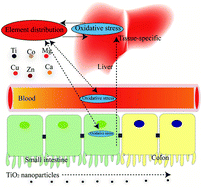Tissue-specific oxidative stress and element distribution after oral exposure to titanium dioxide nanoparticles in rats†
Abstract
Dietary and environmental exposure to titanium dioxide nanoparticles (TiO2 NPs) can cause low-dose and long-term oral exposure in the population, posing a potential adverse health risk. Oxidative stress is considered to be the primary effect of TiO2 NPs through biological interaction. In the present study, we conducted an animal experiment to investigate the element distribution and oxidative stress in Sprague-Dawley rats after oral exposure to TiO2 NPs at daily doses of 0, 2, 10, and 50 mg kg−1 for 90 days. Through the detection of Ti element content in various tissues, limited absorption and distribution of TiO2 NPs in rats was found. However, orally ingested TiO2 NPs still induced tissue-specific oxidative stress and imbalance of elements. Liver tissue was the most sensitive tissue to TiO2 NP-induced oxidative stress, showing decreased reduced glutathione (GSH), increased oxidized glutathione (GSSG) and decreased ratio of GSH/GSSG as well as accumulation of lipid peroxidation (malondialdehyde, MDA) in liver tissues of rats after TiO2 NP exposure (10 and 50 mg kg−1). Meanwhile, oral exposure to TiO2 NPs caused a significant reduction in metal elements such as Mg, Ca and Co in various tissues. Through bioinformatics analysis, the tissue specificity and correlation between the imbalance of elements and oxidative stress were statistically confirmed, but it was difficult to understand the causal relationship. Disorder of element distribution and oxidative stress may lead to a series of subsequent adverse health effects and the tissue specificity would partly explain the target effects of TiO2 NPs.



 Please wait while we load your content...
Please wait while we load your content...